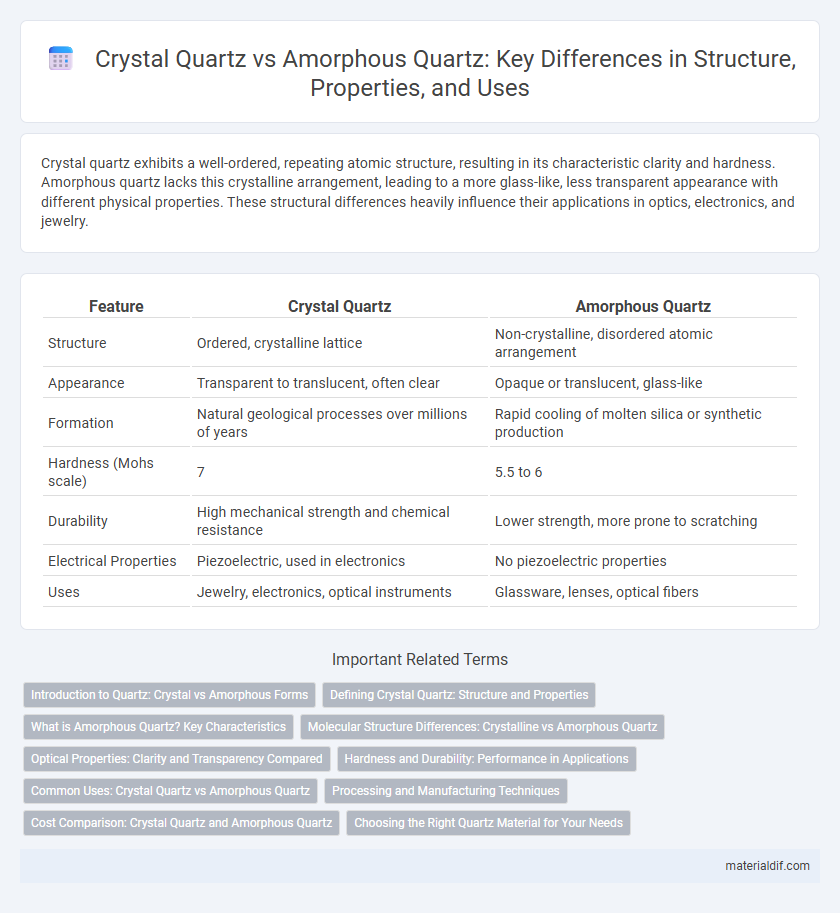Crystal quartz exhibits a well-ordered, repeating atomic structure, resulting in its characteristic clarity and hardness. Amorphous quartz lacks this crystalline arrangement, leading to a more glass-like, less transparent appearance with different physical properties. These structural differences heavily influence their applications in optics, electronics, and jewelry.
Table of Comparison
| Feature | Crystal Quartz | Amorphous Quartz |
|---|---|---|
| Structure | Ordered, crystalline lattice | Non-crystalline, disordered atomic arrangement |
| Appearance | Transparent to translucent, often clear | Opaque or translucent, glass-like |
| Formation | Natural geological processes over millions of years | Rapid cooling of molten silica or synthetic production |
| Hardness (Mohs scale) | 7 | 5.5 to 6 |
| Durability | High mechanical strength and chemical resistance | Lower strength, more prone to scratching |
| Electrical Properties | Piezoelectric, used in electronics | No piezoelectric properties |
| Uses | Jewelry, electronics, optical instruments | Glassware, lenses, optical fibers |
Introduction to Quartz: Crystal vs Amorphous Forms
Quartz exists in two primary forms: crystal and amorphous, each with distinct structural properties. Crystal quartz features a well-ordered, repeating lattice structure that imparts clarity and defined geometric shapes, making it valuable in electronics and optics. Amorphous quartz lacks this long-range order, resulting in a non-crystalline form often found in natural glass-like substances such as obsidian.
Defining Crystal Quartz: Structure and Properties
Crystal quartz is a crystalline form of silicon dioxide characterized by a highly ordered atomic structure where silicon and oxygen atoms form a continuous framework of SiO4 tetrahedra. This hexagonal crystal system exhibits distinct physical properties such as piezoelectricity, hardness of 7 on the Mohs scale, and clarity, making it valuable in electronic and optical applications. In contrast, amorphous quartz lacks a long-range atomic order, resulting in different mechanical and optical behaviors.
What is Amorphous Quartz? Key Characteristics
Amorphous quartz is a non-crystalline form of silicon dioxide lacking the well-defined atomic structure found in crystal quartz. Key characteristics include its irregular, disordered atomic arrangement, absence of long-range periodicity, and typically lower density and hardness compared to crystalline counterparts. This form of quartz often appears in natural glasses like obsidian or synthetic materials such as fused silica, valued for its optical clarity and thermal stability.
Molecular Structure Differences: Crystalline vs Amorphous Quartz
Crystal quartz features a highly ordered molecular structure where silicon-oxygen tetrahedra form a repeating three-dimensional crystal lattice, resulting in a defined geometric pattern that contributes to its clarity and piezoelectric properties. In contrast, amorphous quartz lacks this long-range order, with silicon-oxygen bonds arranged randomly, creating a non-crystalline solid commonly found in natural glassy forms such as fused quartz. These structural differences significantly impact the physical characteristics and applications, where crystalline quartz is prized for its optical and electronic uses, while amorphous quartz excels in thermal and chemical resistance.
Optical Properties: Clarity and Transparency Compared
Crystal quartz exhibits high clarity and exceptional transparency due to its well-ordered atomic lattice, allowing light to pass through with minimal distortion. In contrast, amorphous quartz lacks a regular crystal structure, resulting in lower clarity and a more diffused light transmission. These differences in optical properties make crystal quartz ideal for precision lenses and optical instruments, while amorphous quartz finds use in applications where uniform light diffusion is preferred.
Hardness and Durability: Performance in Applications
Crystal quartz exhibits a hardness of 7 on the Mohs scale, providing excellent durability and resistance to scratching, making it ideal for precision instruments and durable electronics. Amorphous quartz, lacking a crystalline structure, is generally softer and more prone to wear, limiting its application in high-stress environments. The superior mechanical strength and consistent hardness of crystal quartz ensure better performance in demanding applications compared to its amorphous counterpart.
Common Uses: Crystal Quartz vs Amorphous Quartz
Crystal quartz, known for its well-defined lattice structure, is commonly used in electronics and optical devices due to its precise piezoelectric properties, making it essential in clocks, radios, and sensors. Amorphous quartz, lacking a crystalline structure, finds applications in glassmaking, ceramics, and optical fibers because of its uniformity and ability to be molded into various shapes. The distinct structural differences directly influence their suitability, with crystal quartz preferred for precision instruments and amorphous quartz favored in manufacturing processes requiring malleability and transparency.
Processing and Manufacturing Techniques
Crystal quartz undergoes precise cutting and polishing techniques to enhance its optical clarity and structural integrity, often involving heat treatment to improve its crystalline lattice. Amorphous quartz, such as fused quartz, is produced through melting and rapid cooling processes that prevent crystal formation, resulting in a non-crystalline, glass-like structure. Specialized manufacturing methods like flame fusion and chemical vapor deposition are employed to control purity and uniformity in both types for industrial and technological applications.
Cost Comparison: Crystal Quartz and Amorphous Quartz
Crystal quartz, with its well-ordered atomic structure, generally commands a higher market price due to its clarity, durability, and demand in jewelry and high-precision optics. Amorphous quartz, lacking a crystalline lattice, is typically less expensive and is favored in industrial applications such as glass manufacturing and electronic components where structural perfection is less critical. Cost variations also depend on factors like purity, size, and source, but overall, crystal quartz remains more costly compared to amorphous quartz.
Choosing the Right Quartz Material for Your Needs
Crystal quartz exhibits a highly ordered atomic structure, providing superior durability and piezoelectric properties ideal for precision instruments and jewelry. Amorphous quartz lacks this organized lattice, resulting in a more flexible but less stable material suited for applications like glass manufacturing and optical fibers. Selecting crystal quartz ensures enhanced mechanical strength and clarity, while amorphous quartz offers versatility and cost-effectiveness depending on your specific functional requirements.
Crystal Quartz vs Amorphous Quartz Infographic

 materialdif.com
materialdif.com